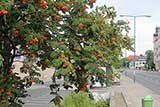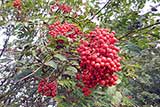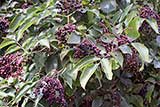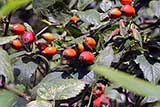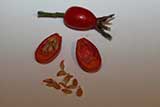Meats and Sausages
Fruit and Berries
Fully ripened fresh fruit contains the most sugar, juice and the strongest aroma. Any damaged, partly fermented or suspicious fruit must be discarded as it will adversely affect the quality of the product. Frozen fruit is fine as freezing preserves the original quality of the fruit, and, the expanding ice crystals damage the fruit's cell structure which contributes to a strong juice extract later in the maceration process.
Wild fruit is also fine. It may produce less juice than a garden variety, but it exhibits a stronger flavor and color, and also contains more aromatic substances. This can be attributed to the fact that wild growing fruit is generally smaller, and contains proportionally more skin relative to its flesh. The substances which are responsible for the color, flavor and aroma of the fruit are mainly located in the skin. Green unripe walnuts make one of the most popular Polish infusions (Orzechowka - nut cordial).
Dry fruit such as prunes, raisins or figs contain little moisture but retain almost all of the original flavor and aroma compounds. Dry plums will produce clearer infusions than fresh ones. Avoid prunes which carry a smoky flavor. Dry citrus skins deliver a wonderful aroma and produce clear vodkas.
All fruits are suitable for making infusions:
Fruits with pits - plums, sour cherries, cherries, peaches, apricots. Pits are discarded as they may contain traces of cyanide which exhibits an intense odor of bitter almonds. However, if the dosage is properly administered, this aroma contributes positively to the overall flavor of the drink. The accepted practice is to retain about 20-25% of pits in relation to the weight of the fruit base. For example pitted tart (sour) cherries make great infusions, but if 20% of pits are added to the must, the infusion becomes simply superb, displaying a delicate touch of an almond aroma.
Fruits with seeds - apples, oranges, pears, quinces, wild rose, dogwood, and hawthorn. Most seeds should be removed as they generally impart a bitter taste. Seeds from apples, oranges or pears contain pectin which develops cloudiness in the juice.
Berries - blackberries, black and red currants, raspberries, strawberries, rowan, gooseberries, elderberries. Berries make great alcoholic beverages.
Rowan berries. From Wikipedia:
The European Rowan (Sorbus aucuparia), a small tree typically 4' 12 m tall growing in a variety of habitats throughout northern Europe and in mountains in southern Europe and southwest Asia. Its berries are a favorite food for many birds and are a traditional wild-collected food in Britain and Scandinavia. It is one of the hardiest European trees, growing even in Arctic Norway, and has also become widely naturalized in northern North America.
The encyclopedia does not mention the fact that rowan berries make one of the finest dry vodkas possible. It had been extremely popular in Poland once (Jarzebiak) and was widely distributed. Rowan berries have a tartness and a sweetness that makes them excellent for making jellies and vodka. The best time for harvest is after the first frost when berries lose their bitter taste and become slightly sweet.
Fruits contain plenty of water, 82-88%, the rest are sugars (5-10%), ash (0.3-0.7%), pectin (0.2-1%) acids (0.2-3%) and cellulose (0.3- 5%). Fruit that grows in warmer climates is generally sweeter, for example Polish plums may contain 10% sugar, but the same variety grown in Bulgaria contains 15-20% sugar. Oranges that are grown in Europe, Florida or California will also exhibit some differences.
Fruit Preparation
- Fruit must be washed. Soft, delicate fruits such as raspberries are generally not washed as they will lose too much juice. They may be showered cautiously taking care not to agitate the skin.
- Fruit is broken, smashed into smaller parts which breaks cell and skin structure, facilitating juice extraction. However, fruit should not be pulverized in a food processor as this will produce a cloudier juice.
Depending on the ease of obtaining juice, the fruit can be classified into two groups:
1. Apples, grapes, strawberries, sour cherries - fruits that either contain little pectin, or have pectin that does not readily dissolve in water. Those fruits leave a lot of pulp and release a relatively clear juice.
2. Apricots, black currants, raspberries, plums, peaches, citrus and other tropical fruit - these fruits contain a harder skin and pectin that does not dissolve easily in water. The fruit from the second group is usually prepared for juicing by:
A. Breaking it into smaller particles and resting them for 4-12 hours. This starts pectin reactions which soften the skin and helps to recover more juice.
B. Commercial producers add specially prepared enzymes which help extract more juice. Commercial presses are very efficient and will deliver from 60 - 80% juice in relation to the weight of material.
Alcohol Fruit Juice
If freshly obtained juice will be stored, it is mixed with alcohol to obtain a 16-20% alcoholic solution. This amount of alcohol will preserve the juice by preventing natural yeasts from starting fermentation. Such alcohol preserved juice is known in Poland as fruit mors. Commercial producers mix those alcohol preserved juices with essential oils, alcohol, syrups, infusions and other ingredients when they compose a new drink. The amount of particular alcohol that is needed to produce alcohol juice at a certain strength can be easily calculated using the following equation:
- X = A x s/(S-s)
- X - the needed amount of alcohol that would be added to juice.
- A - the amount of juice that would be mixed with alcohol.
- S - the strength of alcohol that would be added to juice.
- s - the strength of alcohol juice that would be obtained.
We have 75% alcohol and we want to produce 1 liter of alcohol juice at 19%. Solution: 1 x 19/(75-19) = 19/56 = 0.339 l = 340 ml If we mix 340 ml of 75% alcohol with 1 l juice we will obtain alcohol juice at 19% alcohol strength.
Using 95% Alcohol
| Alcohol | Fruit juice | Alcohol juice strength |
|---|---|---|
| 250 ml | 1000 ml | 19% |
| 200 ml | 1000 ml | 16% |
Using 75% Alcohol
| Alcohol | Fruit juice | Alcohol juice strength |
|---|---|---|
| 340 ml | 1000 ml | 19% |
| 270 ml | 1000 ml | 16% |
Alcohol juice is usually made by mixing 0.25 liter 95% alcohol with 1 liter of juice in a 1:4 ratio. As in most places in the USA the strongest obtainable alcohol is 75%, the proportion becomes: 1 liter of juice to 340 ml 75° alcohol. In both cases the resulting drinks contain about 19% of alcohol. Alcohol juice is often made from the leftover liquid after the second infusion. Such preserved fresh juice is stored for up to 12 months for later use as a component of flavored spirits. Naturally, it is delicious to drink at any time. Freshly produced alcohol juice should not be used for 14-30 days. Alcohol tends to extract microscopic particles such as pectin, tannin, proteins, etc. Those particles need some time to sink to the bottom and produce a clear juice. This is the same process as clarifying wine. After that period the clear juice is siphoned and the sediment discarded. Even after all those procedures certain juices like plum or lemon may still remain cloudy.
Infusions
Although infusions hold their own right as a type of alcoholic spirits, they may also be considered a material that can be blended with alcohol for making flavored vodkas. They may be the main ingredient or the supplementary one. Infusions are wonderful materials, however, their production requires so much time and space that commercial producers tend to stay away from them. The industry prefers to use alcohol juices. Infusions, however, are clearer and more flavorsome than alcohol juices and a hobbyist can use them for making a variety of sophisticated blends. Fruits such as blackthorn, rowan, bird cherry, and hawthorn contain a large pit but little flesh. Obtaining juice from such fruits by pressing is difficult and infusion produces the best results.

